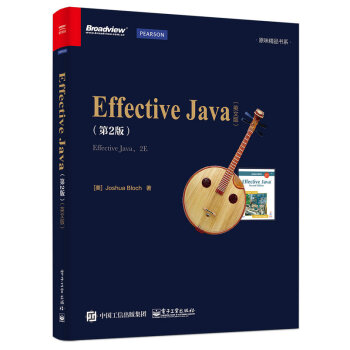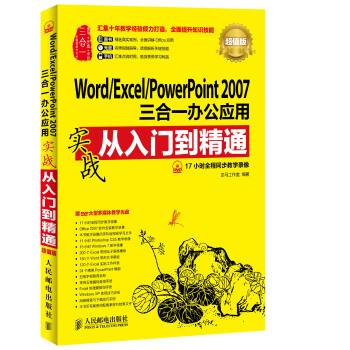

具体描述
产品特色
内容简介
《Effective Java(第2版 英文版)》介绍了在Java编程中的78条非常具有实用价值的经验规则,这些经验规则涵盖了大部分开发人员每天所面临的问题的解决方案。通过对Java平台设计专家所使用的技术的全面描述,揭示了应该做什么,不应该做什么,以及怎样才能编写出清晰、健壮和高效的代码。《Effective Java(第2版)英文版》中的每条规则都以简短、独立的小文章形式出现,并通过示例代码进一步进行说明。本书内容全面,结构清晰,讲解详细,可作为技术人员的参考用书。目录
推荐序前言
1 Introduction
2 Creating and Destroying Objects
Item 1: Consider static factory methods instead of constructors
Item 2: Consider a builder when faced with many constructor parameters
Item 3: Enforce the singleton property with a private constructor or an enum type
Item 4: Enforce noninstantiability with a private constructor
Item 5: Avoid creating unnecessary objects
Item 6: Eliminate obsolete object references
Item 7: Avoid finalizers
3 Methods Common to All Objects
Item 8: Obey the general contract when overriding equals
Item 9: Always override hashCode when you override equals
Item 10: Always override toString
Item 11: Override clone judiciously
Item 12: Consider implementing Comparable
4 Classes and Interfaces
Item 13: Minimize the accessibility of classes and members
Item 14: In public classes, use accessor methods, not public fields
Item 15: Minimize mutability
Item 16: Favor composition over inheritance
Item 17: Design and document for inheritance or else prohibit it
Item 18: Prefer interfaces to abstract classes
Item 19: Use interfaces only to define types
Item 20: Prefer class hierarchies to tagged classes
Item 21: Use function objects to represent strategies
Item 22: Favor static member classes over nonstatic
5 Generics
Item 23: Don’t use raw types in new code
Item 24: Eliminate unchecked warnings
Item 25: Prefer lists to arrays
Item 26: Favor generic types
Item 27: Favor generic methods
Item 28: Use bounded wildcards to increase API flexibility
Item 29: Consider typesafe heterogeneous containers
6 Enums and Annotations
Item 30: Use enums instead of int constants
Item 31: Use instance fields instead of ordinals
Item 32: Use EnumSet instead of bit fields
Item 33: Use EnumMap instead of ordinal indexing
Item 34: Emulate extensible enums with interfaces
Item 35: Prefer annotations to naming patterns
Item 36: Consistently use the Override annotation
Item 37: Use marker interfaces to define types
7 Methods
Item 38: Check parameters for validity
Item 39: Make defensive copies when needed
Item 40: Design method signatures carefully
Item 41: Use overloading judiciously
Item 42: Use varargs judiciously
Item 43: Return empty arrays or collections, not nulls
Item 44: Write doc comments for all exposed API elements
8 General Programming
Item 45: Minimize the scope of local variables
Item 46: Prefer for-each loops to traditional for loops
Item 47: Know and use the libraries
Item 48: Avoid float and double if exact answers are required
Item 49: Prefer primitive types to boxed primitives
Item 50: Avoid strings where other types are more appropriate
Item 51: Beware the performance of string concatenation
Item 52: Refer to objects by their interfaces
Item 53: Prefer interfaces to reflection
Item 54: Use native methods judiciously
Item 55: Optimize judiciously
Item 56: Adhere to generally accepted naming conventions
9 Exceptions
Item 57: Use exceptions only for exceptional conditions
Item 58: Use checked exceptions for recoverable conditions and runtime exceptions for programming errors
Item 59: Avoid unnecessary use of checked exceptions
Item 60: Favor the use of standard exceptions
Item 61: Throw exceptions appropriate to the abstraction
Item 62: Document all exceptions thrown by each method
Item 63: Include failure-capture information in detail messages
Item 64: Strive for failure atomicity
Item 65: Don’t ignore exceptions
10 Concurrency
Item 66: Synchronize access to shared mutable data
Item 67: Avoid excessive synchronization
Item 68: Prefer executors and tasks to threads
Item 69: Prefer concurrency utilities to wait and notify
Item 70: Document thread safety
Item 71: Use lazy initialization judiciously
Item 72: Don’t depend on the thread scheduler
Item 73: Avoid thread groups
11 Serialization
Item 74: Implement Serializable judiciously
Item 75: Consider using a custom serialized form
Item 76: Write readObject methods defensively
Item 77: For instance control, prefer enum types to readResolve
Item 78: Consider serialization proxies instead of serialized instances
Appendix: Items Corresponding to First Edition
References
Index
前言/序言
推荐序如果有同事对你说,“Spouse of me this night today manufactures the unusual meal in a home. You will join?”这时候你脑子里可能会浮现出三件事情:同事在邀请你参加他的家庭晚宴,英语肯定不是你这位同事的母语,更多的则是满脑子的疑惑。
如果你曾经学习过第二种语言,并且尝试过在课堂之外使用这种语言,你就该知道有三件事情是必须掌握的:这门语言的结构如何(语法)、如何命名你想谈论的事物(词汇),以及如何以惯用和高效的方式来表达日常的事物(用法)。在课堂上大多只涉及到前面两点,当你使出浑身解数想让对方明白你的意思时,常常会发现当地人对你的表述忍俊不禁。
程序设计语言也是如此。你需要理解语言的核心:它是面向算法的,还是面向函数的,或者是面向对象的?你需要知道词汇表:标准类库提供了哪些数据结构、操作和功能设施(Facility)?你还需要熟悉如何用习惯和高效的方式来构建代码。也许是因为前面两点比较容易编写,所以关于程序设计语言的书籍通常只涉及这两点,或者只是蜻蜓点水般地介绍一下用法。语法和词汇是语言本身固有的特性,但是用法则反映了使用这门语言的群体特征。
例如,Java程序设计语言是一门支持单继承的面向对象程序设计语言,在每个方法的内部,它都支持命令式的(面向语句的,Statement-Oriented)编码风格。Java类库提供了对图形显示、网络、分布式计算和安全性的支持。但是,如何把这门语言以最佳的方式运用到实践中呢?
还有一点,程序与口头的句子以及大多数书籍和杂志都不同,它会随着时间的推移而发生变化。仅仅编写出能够有效地工作并且能够被别人理解的代码往往是不够的,我们还必须把代码组织成易于修改的形式。针对某个任务可能会有10种不同的编码方法,而在这10种编码方法中,有7种编码方法是笨拙的、低效的或者是难以理解的。而在剩下的3种编码方法中,哪一种会是最接近该任务的下一年度发行版本的代码呢?
目前有大量的书籍可以供你学习Java程序设计语言的语法,包括The Java Programming Language [Arnold05](作者Arnold、Gosling和Holmes),以及The Java Language Specification [JLS](作者Gosling、Joy和Bracha)。同样地,与Java程序设计语言相关的类库和API的书籍也有很多。
本书解决了你的第三种需求,即如何以惯用和高效的方式来表达日常的事物(用法)。多年来,作者Joshua Bloch在Sun Microsystems公司一直从事Java语言的扩展、实现和使用的工作;他还大量地阅读了其他人的代码,包括我的代码。他在本书中提出了许多很好的建议,他系统地把这些建议组织起来,旨在告诉读者如何更好地构造代码以便它们能工作得更好,也便于其他人能够理解这些代码,而且将来对代码进行修改和改善时也不至于那么头疼。甚至,你的程序也会因此而变得更加令人愉悦、更加优美和雅致。
Guy L. Steele Jr
Burlington, Massachusetts
2001年4月
用户评价
对于我来说,这本书与其说是一本技术手册,不如说是一位经验丰富的“代码侦探”。它不会直接告诉你“这样做”,而是会带你一步一步地“发现”为什么这样做才是最优解。比如,关于枚举的讨论,我之前只知道enum是个好东西,但书里对它的各种使用方式,以及如何设计更强大的枚举,让我大开眼界。还有关于“不要使用浮点数进行精确计算”这样的常识性错误,书中解释得非常透彻,让我避免了很多潜在的bug。这本书最大的魅力在于,它能让你在阅读的过程中,不断地“啊哈!”“原来如此!”。它不会给你一个现成的答案,而是给你一套思考问题的框架和方法论。我经常会把书中提到的例子,在脑海里复现,或者在本地环境中尝试,然后验证书中的观点。这种主动的学习过程,比被动接受信息要深刻得多。这本书对Java语言的理解,已经达到了“炉火纯青”的地步,并且它毫不吝啬地将这些宝贵的经验分享出来。它让我明白,写出“优秀”的代码,不仅仅是会写,更是需要一种“精益求精”的态度,以及对语言特性深刻的洞察力。我至今仍认为,这本书是我在Java开发领域投资回报率最高的一本书。
评分这本书对我来说,是一次“启蒙”式的阅读体验。在我刚开始深入Java领域的时候,我接触过不少教程和博客,但总觉得它们要么太肤浅,要么太零散,无法形成一个系统的认知。直到我读了这本书,才真正理解了“Effective”这个词的含义。它不是教你如何堆砌功能,而是如何用最优雅、最健壮、最高效的方式去实现功能。书中对各种Java特性的剖析,都达到了非常深入的程度。比如,它关于泛型的讲解,让我彻底理解了为什么需要泛型,以及泛型带来的类型安全和代码复用。还有对并发编程的讨论,虽然可能对初学者来说有些挑战,但它提供的深入见解,让我能更好地理解并发环境下的各种陷阱和解决方案。这本书的作者,显然是对Java这门语言有着极其深刻的理解,并且能够将复杂的概念用清晰、简洁的方式呈现出来。我特别欣赏它那种“就事论事”的风格,不卖弄概念,而是直接切入问题的核心,给出实实在在的建议。很多时候,我会在写完一段代码后,立刻联想到书中的某个条目,然后回头去对照,检查自己是否遵循了最佳实践。这本书的价值,体现在它能帮助你“少犯错”,并且“写出更好的代码”,这对于一个正在成长的Java开发者来说,是无价的。
评分这本书,在我看来,简直就是一本程序员的“圣经”。我第一次接触它的时候,还在学校里,那时候对Java的理解还停留在“能跑就行”的阶段,直到我读了这本书,才意识到自己之前有多么浅薄。它不是那种简单告诉你“怎么做”的书,而是深刻地阐述“为什么这么做”,以及“为什么这样做更好”。每一次读,我都会有新的领悟。比如,关于对象创建的各种模式,一开始我只知道new,但读了这本书,我才明白了工厂方法、建造者模式等等的精妙之处,以及它们在实际开发中能带来多大的灵活性和可维护性。还有关于集合的深度解析,我之前以为Set就是Set,List就是List,但这本书让我明白了各种实现类之间的细微差别,以及在不同场景下应该选择哪种实现才能达到最佳性能。甚至连注释的使用,书中都有非常讲究的指导,让我开始重新审视自己代码的可读性和专业性。我经常会在遇到一个棘手的Java问题时,不自觉地翻开这本书,然后惊喜地发现,它早就为我准备好了最优的解决方案和深入的见解。这本书的语言虽然是英文,但其清晰的逻辑和严谨的论证,即使不是母语读者,也能轻松理解。对我而言,它不仅仅是一本技术书籍,更像是一位经验丰富的导师,指引我在Java开发的道路上不断精进。
评分我一直认为,技术书籍的价值在于它的“实用性”和“前瞻性”。这本书,在这两点上都做得非常出色。它不是那种只讲理论、脱离实际的书,而是字字句句都充满了来自实际开发经验的智慧。书中关于异常处理的章节,让我明白了为什么不应该随意捕获所有异常,以及如何设计更合理的异常处理机制,这直接提升了我代码的鲁棒性。还有对序列化和反序列化的讨论,我之前对这些概念模糊不清,读了这本书才真正理解了其中的奥秘和潜在风险。最让我印象深刻的是,这本书不仅仅停留在Java语言本身,还触及了软件设计和编程哲学的一些深层问题。它引导我思考如何写出更易于维护、更易于扩展的代码,如何让团队协作更顺畅。每一次阅读,我都能从中找到一些能直接应用到我当前项目中的东西,并且这些应用往往能带来显著的改进。这本书的英文表达非常精炼,没有一句废话,每一个观点都经过深思熟虑。我常常觉得,这本书就像一个“质量检查员”,帮助我不断提升自己代码的质量和我的编程素养。
评分说实话,刚拿到这本书的时候,我有点犹豫,毕竟英文原版,而且我当时的项目又急着上线,哪有时间啃一本厚厚的书?但同事极力推荐,说这书是Java程序员必读,我硬着头皮开始翻。结果,一旦开始,就停不下来了。它真的颠覆了我很多之前的认知。以前写代码,总觉得“能跑就行”,或者照搬网上的例子。这本书让我开始思考代码的“质”和“效”。比如,书中对equals()和hashCode()方法的讲解,我以前总是随便写,从来没想过这两个方法之间需要如此严谨的契约关系,一旦写错,带来的连锁反应简直是灾难。还有关于不可变对象的重要性,以及如何设计它们,这让我开始在项目中大量实践,明显感觉代码的健壮性提升了好几个档次。它讲的很多东西,不是那种一蹴而就的技巧,而是需要反复琢磨,并且在实践中去体会。每次遇到性能瓶颈或者设计难题,我都会想起书中的某个章节,然后回去对照,经常能找到意想不到的灵感。它让我明白,写出“好”的代码,不仅仅是功能的实现,更是对细节的把握,对设计原则的遵循,以及对潜在问题的预见。这本书就像一把尺子,让我能衡量自己代码的优劣,并指明了改进的方向。
评分好好好好好好好好好好好好好好好好好好好好好好好
评分很好很好很好很好很好很好
评分英文版买来收藏
评分英文版的看的有点难过
评分书看了,讲解的很详细,到位,作为菜鸟的我,看了这书就觉得对我很有帮助
评分好好享受吧,专业必备的书籍,很强大。
评分很好很好很好很好很好很好
评分其他两本书都有包装,为什么它没有,还一堆指甲印
评分还没看。大概翻了几页。还不错。是正版
相关图书
本站所有内容均为互联网搜索引擎提供的公开搜索信息,本站不存储任何数据与内容,任何内容与数据均与本站无关,如有需要请联系相关搜索引擎包括但不限于百度,google,bing,sogou 等
© 2025 book.coffeedeals.club All Rights Reserved. 静流书站 版权所有




















